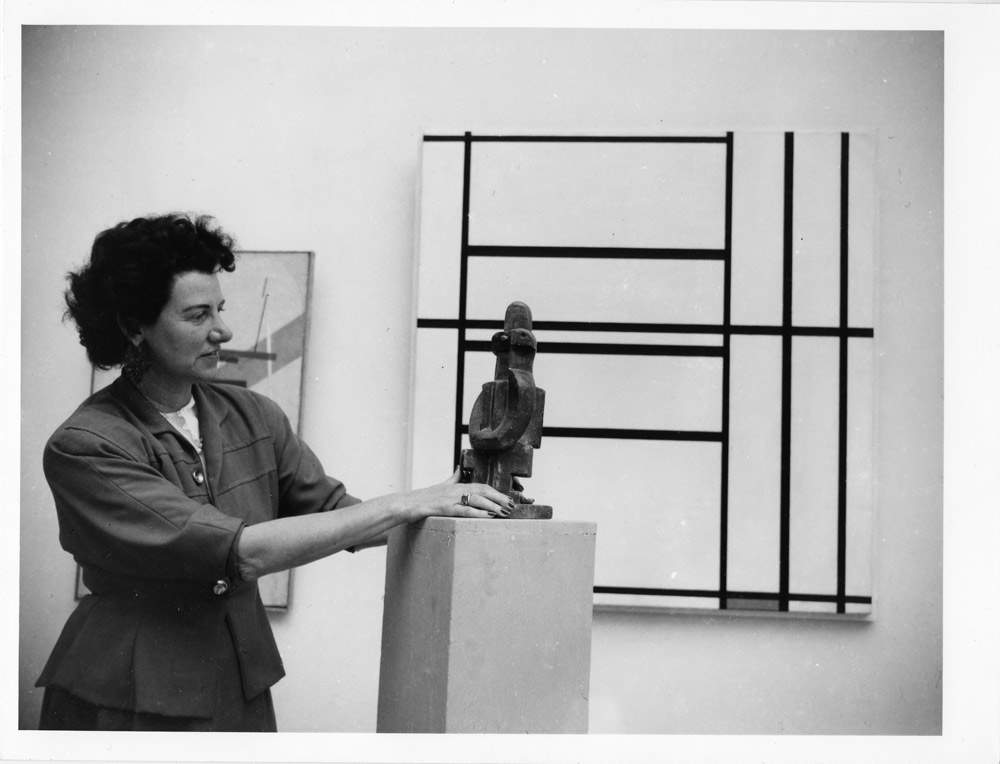Peggy Guggenheim's Biennale 70 years ago: an exhibition in Venice pays tribute to the great collector
It was the year 1948 when the celebrated collector Peggy Guggenheim (New York, 1898 - Camposampiero, 1979) exhibited her collection at the XXIV Venice Biennale, in the premises of the Greek Pavilion. Exactly 70 years later, the Peggy Guggenheim Collection in Venice, in the Project Rooms spaces dedicated to temporary exhibitions, commemorates the collection’s founder with an exhibition titled 1948: Peggy Guggenheim’s Biennale and curated by Graina Subelyte, the museum’s Assistant Curator. The exhibition runs from May 25 to November 25, 2018, and aims to recreate the environment of the Greek Pavilion in 1948 with documents, photographs, letters, and a reconstruction of the original arrangements that were followed by the great architect Carlo Scarpa. In addition, the itinerary showcases some of the iconic works on display then, such as Composition No. 113 (1939) by Friedrich Vordemberge-Gildewart (Osnabrück, 1899 - Ulm, 1962) and Composition (1936) by Jean Hélion (Couterne, 1904 - Paris, 1987), both of which are now preserved in Tel Aviv and have never been exhibited in Venice since 1948. In fact, many of the works then exhibited were later donated to various museums around the world.
The exhibition, reads the presentation, “will therefore offer the opportunity to re-examine this event as a watershed in Peggy’s career and in the very history of the Venice Biennale. Indeed, the collection offered Europeans the opportunity to catch up with the best results of the most recent avant-garde, and to get to know the New York artists who would dominate the art scene of the 1950s.” It was an important exhibition, and the pavilion housing Peggy Guggenheim’s works was also visited by the president of the republic, Luigi Einaudi, and the U.S. ambassador to Italy, James Dunn, as well as several art and cultural figures, beginning with the great art historian Bernard Berenson, and the equally great Lionello Venturi, who was moreover photographed by Lee Miller while visiting the pavilion (and Lee Miller herself, in British Vogue magazine, called Peggy’s “the most sensational” of all the pavilions of the XXIV Biennale). The exhibition was also the first public display of a private collection of modern art in Italy since Fascism, and it also constituted the first presentation of the Guggenheim collection in Europe, after the closure of the Art of this Century gallery in New York and Peggy Guggenheim’s move to Venice. The collector was invited to participate in the Biennale by then Secretary General Rodolfo Pallucchini, who was in turn advised by artist Giuseppe Santomaso.
The result was an unprecedented exhibition of one hundred and thirty-six works, since Peggy Guggenheim’s collection was highly representative of all the avant-gardes and the most up-to-date schools: the collection included Cubist, Futurist, Dadaist, and Surrealist works, as well as early works by the Abstract Expressionists. As a result, the Biennale also benefited from the exhibition. “My exhibition,” Peggy Guggenheim wrote in A Life for Art, “resonated enormously, and my pavilion became one of the most popular at the Biennale. All this excited me terribly, but what pleased me most was to see the name Guggenheim appear on the lawns of the public gardens next to those of Great Britain, France, Holland, Austria, Switzerland, Poland [ ] It seemed to me that I was a new European country.”
The exhibition can be visited during the opening hours of the Peggy Guggenheim Collection in Venice: daily (except Tuesdays, closing day) from 10 a.m. to 6 p.m. Lesposition is open daily (except Tuesdays, closing day) from 10 a.m. to 6 p.m. The exhibition can be accessed with the museum ticket: full 15 euros, 13 euros the reduced over 65, FAI members, COOP members and holders of Alitalia flight boarding passes to or from Venice (up to a maximum of 7 days before the visit), 9 euros the reduced for under 26, school groups, UNESCO members, IAA, AIAP, ANISA, Amici Musei Venezia, people with mild disabilities without an accompanying person, journalists, law enforcement, Fidelity Card holders Teatro Goldoni of Venice or Teatro Verdi of Padua, free for children up to 10 years old, disabled with accompanying person, Advisory Board members, The International Patrons, Guggenheim Circle, Friends of the Collection, members of museums run by the Solomon R. Guggenheim with membership cards, employees of the Intrapresae Guggenheim Collection, ART PAAS members, AAMD, ICOM, ICOMOS, accredited journalists, students of the Venice Academy of Fine Arts and the Venice High School of Art, members of the Venice Tourist Guide Association, Chiavi dOro members, members of affiliated museums (the list is on the Peggy Guggenheim Collection website, where you can also find the exhibition info). Guided tours are held daily at 3:30 pm. Information and reservations: phone 041.2405.422 / 432, fax 041.520.6885, email shop@guggenheim-venice.it. 1948: The Peggy Guggenheim Biennial has received the support of Peter Lawson-Johnston, President Emeritus of the Peggy Guggenheim Collection, and the Peggy Guggenheim Collection exhibition program is supported by Institutional Patrons EFG and Lavazza, Guggenheim Intrapresæ, and the museum’s Advisory Board. Educational projects are carried out with the support of the Araldi Guinetti Foundation, Vaduz.
Pictured: Peggy Guggenheim at the Greek pavilion next to Jacques Lipchitz, Seated Pierrot (1922); behind Piet Mondrian, Composition No. 1 with Gray and Red 1938 / Composition with Red 1939 (193839), XXIV Venice Biennale, 1948 (Modern print; Solomon R. Guggenheim Foundation, Venice, photo Archivio Cameraphoto Epoche. Gift, Cassa di Risparmio di Venezia, 2005).
 |
| Peggy Guggenheim's Biennale 70 years ago: an exhibition in Venice pays tribute to the great collector |
Warning: the translation into English of the original Italian article was created using automatic tools. We undertake to review all articles, but we do not guarantee the total absence of inaccuracies in the translation due to the program. You can find the original by clicking on the ITA button. If you find any mistake,please contact us.




























